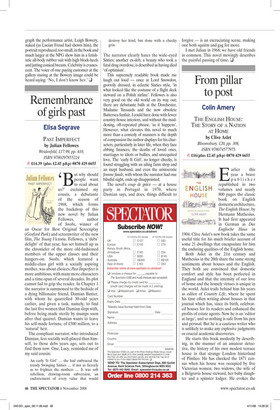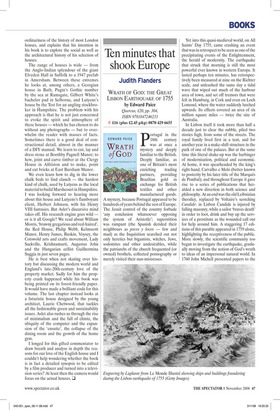From pillar to post
Colin Amery
THE ENGLISH HOUSE: THE STORY OF A NATION AT HOME by Clive Aslet Bloomsbury, £20, pp. 308, ISBN 978074577973 V £16(plus £2.45 p&p) 0870 429 6655 Earlier this year a brave publisher republished in two volumes and nearly 800 pages the classic book on English domestic architecture, The English House, by Hermann Muthesius. It had first appeared in German as Das Englische Haus in 1904. Clive Aslet’s new book takes the same useful title for his much briefer account of some 21 dwellings that encapsulate for him the enduring qualities of the English home.
Both Aslet in the 21st century and Muthesius in the 20th share the same strong sentiments about houses and the English. They both are convinced that domestic comfort and style has been perfected in England and that the intensity of our love of home and the homely virtues is unique in the world. Aslet trails behind him his years as editor of Country Life, where he spent his time often writing about houses in that journal which has, since its birth, celebrated houses for its readers and enhanced the profits of estate agents. Now he is an ‘editor at large’, and so nothing is safe from his pen and perusal. But he is a cautious writer who is unlikely to make any explosive judgments or crucial academic discoveries.
He starts this book modestly by describing, in the manner of an amateur detective, the history of his own modest terrace house in that strange London hinterland of Pimlico. He has checked the 1871 census when his house was occupied by five Victorian women; two widows, the wife of a Belgravia house steward, her baby daughter and a spinster lodger. He evokes the ordinariness of the history of most London houses, and explains that his intention in his book is to explore the social as well as the architectural history of his selection of houses.
The range of houses is wide — from the Anglo-Indian splendour of the giant Elveden Hall in Suffolk to a 1947 prefab in Amersham. Between these extremes he looks at, among others, a Georgian house in Bath, Pugin’s Gothic number by the sea at Ramsgate, Gilbert White’s bachelor pad in Selborne, and Lutyens’s house by the Test for an angling stockbroker in Hampshire. The problem with his approach is that he is not just concerned to evoke the spirit and atmosphere of these houses — which he has chosen to do without any photographs — but to overwhelm the reader with masses of facts. Sometimes there is a good deal of constructional detail, almost in the manner of a DIY manual. We learn to cut, lay and dress stone at Boothby Pagnell Manor; to hew, joint and carve timber at the Clergy House in Alfriston and to make, point and cut bricks at East Barsham Manor.
We even learn how to dig in the lower chalk beds to find clunch — the hardest kind of chalk, used by Lutyens as the local material to build Marshcourt in Hampshire. I was looking forward to hearing more about this house and Lutyens’s flamboyant client, Herbert Johnson, with his Henry VIII fantasies. But Aslet’s discursive mind takes off. His research engine goes wild — or is it all Google? We read about William Morris, ‘brawny gregarious and red-haired’, the Red House, Philip Webb, Kelmscott Manor, Henry James, Ruskin, Voysey, the Cotswold arts and crafts movement, Lady Sackville, Krishnamurti, Augustus John and the Hungarian cellist Guilhermina Suggia in just seven pages.
He is best when not skating over history but discussing the modern world and England’s late-20th-century love of the property market. Sadly for him the property crash happened while his book was being printed on its forest-friendly paper. It would have made a brilliant coda for this volume. The last chapter instead looks at a futuristic house designed by the young architect, Laurie Chetwood, that tackles all the fashionable green and sustainability issues. Aslet also rushes us through the rise of minimalism and the fall of chintz, the ubiquity of the computer and the expansion of the ‘ensuite’, the collapse of the dining room and the growth of the home gym.
I longed for this gifted commentator to draw breath and analyse in depth the reasons for our love of the English house and I couldn’t help wondering whether the book is in fact a detailed synopsis to be edited by a film producer and turned into a television series? At least then the camera would focus on the actual houses. q



















































































 Previous page
Previous page